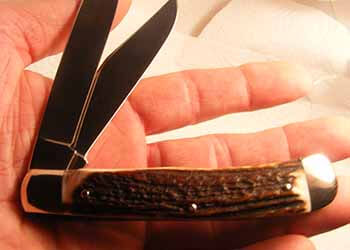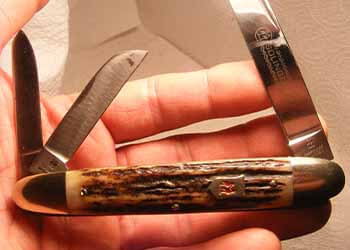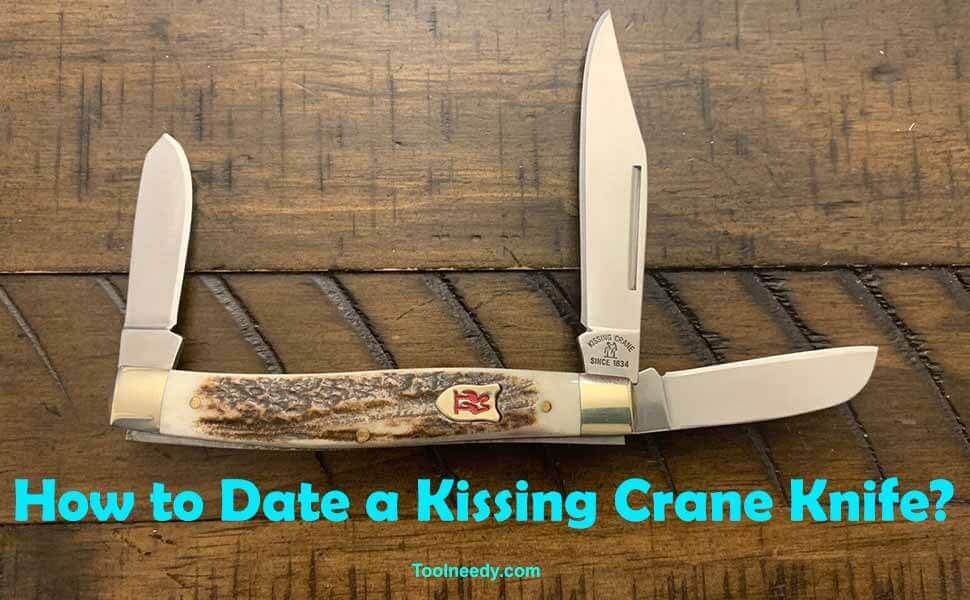Are you ready to embark on a unique dating experience that combines timeless elegance with razor-sharp charm? If so, allow me to introduce you to the enchanting world of dating a Kissing Crane knife. Steeped in rich history and renowned for their impeccable craftsmanship, Kissing Crane knives are more than just tools; they are cherished companions that exude both beauty and utility. Whether you’re a collector or an avid enthusiast, learning how to date a Kissing Crane knife can unlock a captivating journey into the past, where every blade tells a story of its own. So, let’s delve into the secrets of this extraordinary courtship, as we explore the art and intrigue behind how to date a kissing crane knife.
Contents
History of the Kissing Crane Knife

The history of the Kissing Crane knife is as rich and fascinating as the blades themselves. The origins of this iconic brand can be traced back to 19th-century Solingen, Germany, a city renowned for its exceptional knife-making craftsmanship. It was in this picturesque town that the Kissing Crane brand was born, under the visionary leadership of the Böker family.
The Böker family, with their passion for quality and dedication to precision, established the brand with a commitment to creating superior knives that would stand the test of time. The name “Kissing Crane” was chosen to symbolize the brand’s exceptional attention to detail and the seamless “kiss” of the blade when opening and closing the knife.
Over the years, Kissing Crane knives gained widespread recognition for their exceptional quality, stunning aesthetics, and impeccable performance. The brand became synonymous with excellence, attracting a loyal following of knife enthusiasts, collectors, and craftsmen worldwide.
One of the hallmarks of Kissing Crane knives is their traditional design. The brand has always stayed true to its roots, honoring the heritage of Solingen craftsmanship while incorporating modern techniques to enhance functionality. Each knife is meticulously crafted, often featuring intricate handles made from premium materials such as bone, wood, or stag horn, and blades forged from high-quality stainless steel.
Kissing Crane knives have become prized collector’s items, with certain models achieving legendary status. From classic pocket knives and trappers to Bowie knives and hunting blades, Kissing Crane offers a wide range of styles to suit diverse tastes and purposes.
Today, Kissing Crane continues to captivate knife enthusiasts with its unwavering commitment to quality and timeless elegance. The brand’s legacy lives on, as each Kissing Crane knife carries with it the heritage of German craftsmanship and the spirit of innovation that has defined the brand for over a century.
Related: How to Date a Carl Schlieper Knife?
How to Date a Kissing Crane Knife?

Research and Identification:
Begin by gathering information about Kissing Crane knives and their various models throughout history. Study catalogs, online resources, and collector’s guides to familiarize yourself with the different styles, markings, and features of Kissing Crane knives. This knowledge will help you identify the era and model of your knife.
Check The Stamp, Logo, Or Code:
When it comes to dating a Kissing Crane knife, one crucial step is to check the stamp, logo, or code on the knife. These markings often hold valuable information that can help determine the knife’s age and origin. Here’s how you can go about it:
- Examine the Blade: Carefully inspect the blade of your Kissing Crane knife. Look for any stamped markings, engravings, or logos. These can typically be found on the tang (the portion of the blade that extends into the handle).
- Decode the Tang Stamp: Tang stamps on Kissing Crane knives often include the brand name, sometimes accompanied by additional details. Study the stamp closely and try to decipher the information it provides. This may include the company name (e.g., “Kissing Crane” or “Robert Klaas”), location (e.g., “Solingen” or “Germany”), and possibly other identifiers.
- Research Tang Stamp Variations: Kissing Crane knives have gone through various changes over the years, and the tang stamps have evolved accordingly. Consult reference materials, online resources, or collector’s guides that document the different tang stamp variations used by Kissing Crane during different time periods. By comparing the stamp on your knife to these references, you can narrow down its potential age range.
- Identify Logos or Codes: In addition to tang stamps, Kissing Crane knives may feature logos or codes that provide further insights. Look for distinct logos or symbols on the blade or handle. These can indicate specific models, limited editions, or collaborations. If you come across any codes or numbers, they might represent manufacturing batches or other internal codes used by the company.
- Seek Expert Opinion: If you encounter difficulties deciphering the stamp, logo, or code on your Kissing Crane knife, consider reaching out to experts, collectors, or forums dedicated to knife identification. They may have encountered similar markings and can offer their knowledge and expertise to help you determine the knife’s age and significance.
Remember to handle the knife with care and use appropriate tools or resources when examining the stamp, logo, or code. By closely examining these markings and conducting thorough research, you can unlock valuable information about your Kissing Crane knife and its place in the brand’s fascinating history.
Evolution of Tang Stamps over Time:
The tang stamps on Kissing Crane knives have gone through several notable evolutions over time. These changes can provide valuable insights into the age and production period of a particular knife. While the following information provides a general overview, it’s important to consult specific references and resources for accurate details on tang stamp variations. Here’s a glimpse into the evolution of Kissing Crane tang stamps:
- Early Tang Stamps (Late 19th Century – Early 20th Century): During the early years (Basically Pre-1950s) of Kissing Crane, tang stamps were often simple and straightforward. They typically featured the company name “Kissing Crane” along with the location “Solingen,” which denoted the renowned knife-making city in Germany.
- Robert Klaas Era (Mid-20th Century): This period is supposed to be in between 1950s-1970s. In the mid-20th century, Kissing Crane knives were produced under the ownership of Robert Klaas. Tang stamps during this era commonly included the brand name “Kissing Crane” and variations of “Robert Klaas” or “Kissing Crane by Robert Klaas.” These stamps were often accompanied by additional details such as the city of origin, “Solingen,” and sometimes “Germany.”
- Modern Era and Additional Details: In more recent years (After 1980s-present), tang stamps on Kissing Crane knives have become more varied and detailed. While still featuring the brand name “Kissing Crane,” tang stamps may also incorporate additional information, such as specific model names, limited edition markings, or collaborations with other brands or designers. These stamps help differentiate and identify different knife lines or special releases within the Kissing Crane collection.
It’s important to note that within each era, there may be further variations and subtleties in tang stamps, such as font changes, logo additions, or alterations to the placement of information. Consulting comprehensive references, collector’s guides, and engaging with knowledgeable enthusiasts can provide a more detailed understanding of the specific tang stamp variations and their corresponding timeframes.
By familiarizing yourself with the evolution of Kissing Crane tang stamps, you can better assess the age and historical significance of your knife. Remember to carefully compare the tang stamp on your knife with reference materials and seek expert advice when needed to ensure accurate dating and identification.
Looking Out For Roman Numerals:
When dating a Kissing Crane knife, it’s important to keep an eye out for Roman numerals as they can provide valuable clues about the knife’s age. Kissing Crane knives have occasionally incorporated Roman numerals in their tang stamps or other markings to indicate specific years or production periods.
Old Kissing Crane knives boast Roman numerals alongside regular numbers. This practice was prevalent from 1972 to 1986.
Even if you’re not well-versed in reading Roman numerals, spotting them confirms that the knife is a Kissing Crane model from this particular era.
Thankfully, deciphering the numbers is straightforward. The Roman numeral stamps began with XI in 1972 and continued to be added annually.
If you’re unfamiliar with Roman numerals, here’s a simple breakdown:
- XII since 1973
- XIII since 1974
- XIV in 1975
- XV in 1976
- …and so on until 1986.
Inspect the Knife:
Examine your Kissing Crane knife closely, paying attention to any distinguishing marks, stamps, or engravings on the blade, handle, or tang. Look for logos, manufacturer’s names, or specific serial numbers that can provide clues about the knife’s production date.
Tang Stamps and Shield Markings:
Kissing Crane knives often feature tang stamps or shield markings that can be invaluable in determining their age. Carefully decipher these markings and compare them to reference materials or online databases that document the various tang stamps used by Kissing Crane over the years.
Handle Materials and Styles:
Consider the materials used for the handle of your Kissing Crane knife. Certain handle materials may have been popular during specific periods, helping to narrow down the knife’s age. Additionally, note any unique handle designs or patterns that are indicative of particular eras in Kissing Crane’s history.
Seek Expert Advice:
If you’re having difficulty dating your Kissing Crane knife, don’t hesitate to reach out to knife experts, collectors, or forums dedicated to vintage knives. They can offer valuable insights, share their experiences, and provide guidance based on their expertise.
Document and Preserve:
Once you’ve gathered information about your Kissing Crane knife’s age and history, it’s essential to document your findings. Take clear photographs of the knife, noting any significant markings or features. Keep a record of the research you conducted and the resources you consulted. This documentation will be valuable for future reference and potential resale.
More Articles:
Frequently Asked Questions:
Are Kissing Crane Knives Good?
Yes, Kissing Crane knives are generally regarded as good knives. With a rich history and commitment to exceptional craftsmanship, Kissing Crane knives offer a combination of beauty and functionality. They are highly regarded for their quality materials, precise construction, and attention to detail. Whether you’re a collector or an avid user, Kissing Crane knives are known for their reliable performance and timeless appeal.
Are Kissing Crane Knives Made In Germany?
Yes, Kissing Crane knives are made in Germany. The brand originated in Solingen, a renowned city in Germany known for its exceptional knife-making tradition. Kissing Crane knives are crafted with precision and expertise by skilled German artisans. The brand takes pride in its German heritage and continues to uphold the country’s reputation for producing high-quality knives. Whether it’s the materials, craftsmanship, or attention to detail, Kissing Crane knives embody the excellence associated with German knife manufacturing.
How can I authenticate a Kissing Crane knife?
To authenticate a Kissing Crane knife, there are a few steps you can take:
- Research: Familiarize yourself with the characteristics, tang stamps, logos, and other identifying features specific to Kissing Crane knives. Study catalogs, reference materials, and online resources to understand the brand’s history and variations.
- Compare: Compare the knife in question with verified examples of authentic Kissing Crane knives. Look for matching tang stamps, logos, handle materials, and overall design details. Any discrepancies or inconsistencies may raise suspicion.
- Seek Expert Opinion: Consult with reputable knife experts, collectors, or forums dedicated to Kissing Crane knives. Experienced enthusiasts can provide insights based on their knowledge and help authenticate the knife based on its features, markings, and overall craftsmanship.
- Verification: If possible, reach out to the manufacturer directly. Kissing Crane may have resources or experts who can assist in verifying the authenticity of their knives. This can be especially helpful for older or rare models.
- Documentation: Keep records of any research, comparisons, expert opinions, or verifications obtained during the authentication process. This documentation will be valuable for future reference and potential resale.
Authenticating a Kissing Crane knife requires careful examination, research, and input from knowledgeable sources. By employing these steps, you can increase your confidence in determining the authenticity of a Kissing Crane knife.
Final Words
In conclusion, Kissing Crane knives are highly regarded for their quality, craftsmanship, and German heritage. With a rich history dating back to Solingen, Germany, these knives embody the excellence associated with German knife manufacturing. They offer a combination of beauty and functionality, making them desirable for collectors and users alike. When authenticating a Kissing Crane knife, thorough research, comparisons, seeking expert opinions, and documenting the process are key. By following these steps, you can ensure the authenticity of a Kissing Crane knife and appreciate its genuine craftsmanship and historical significance.
Image Credit: eBay

